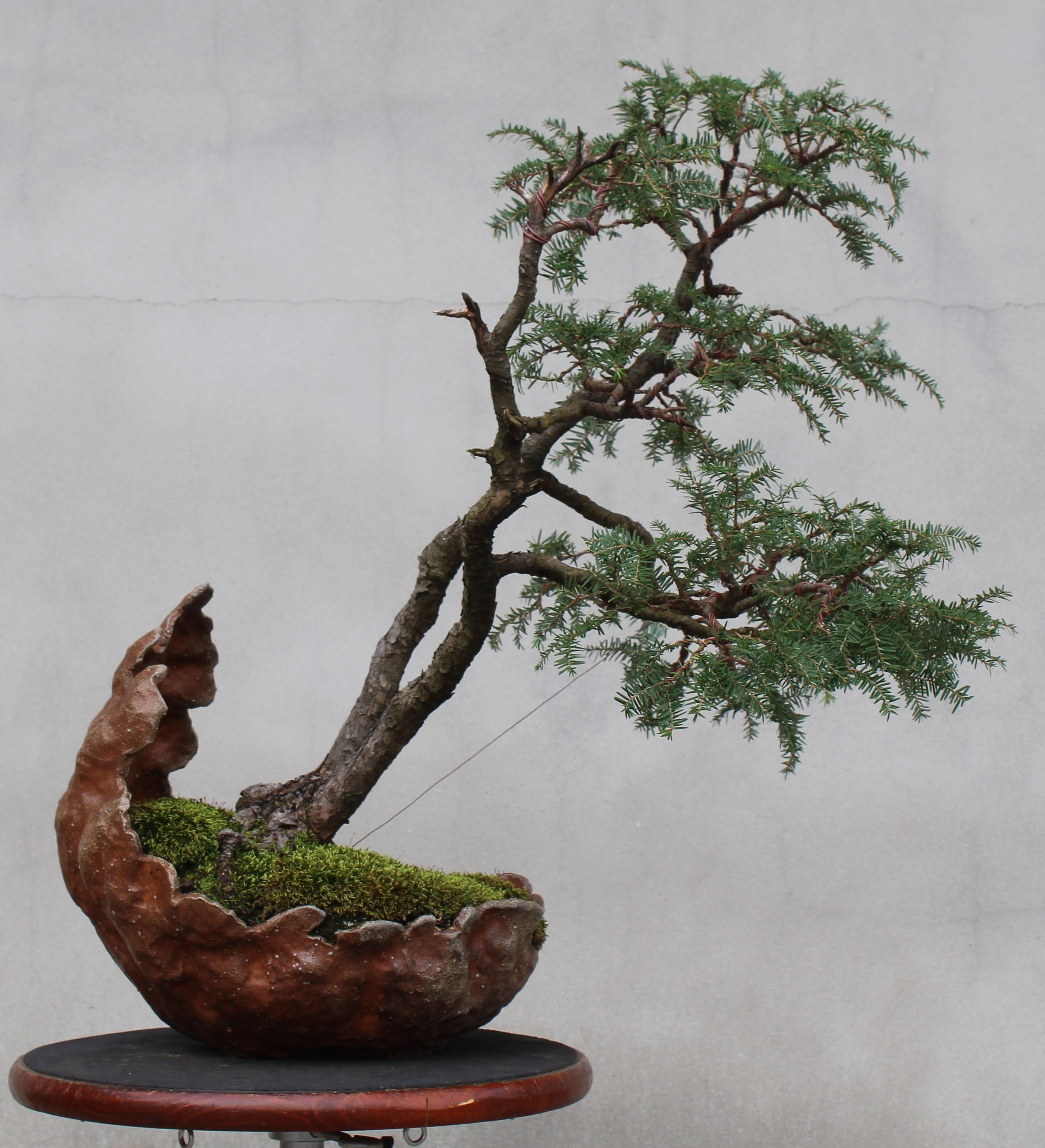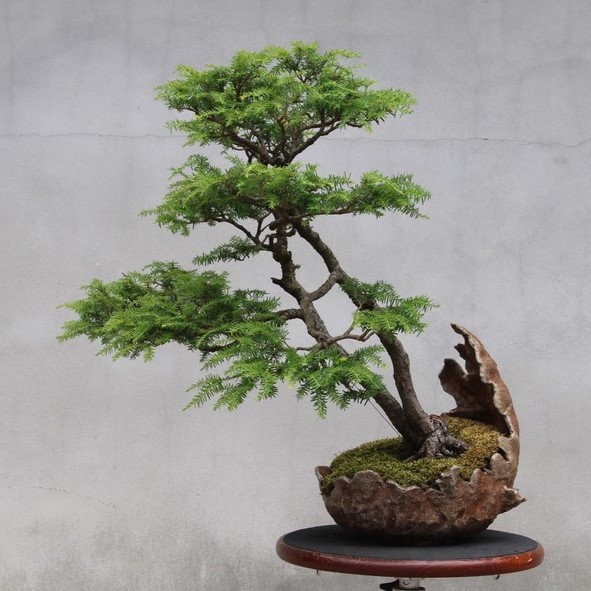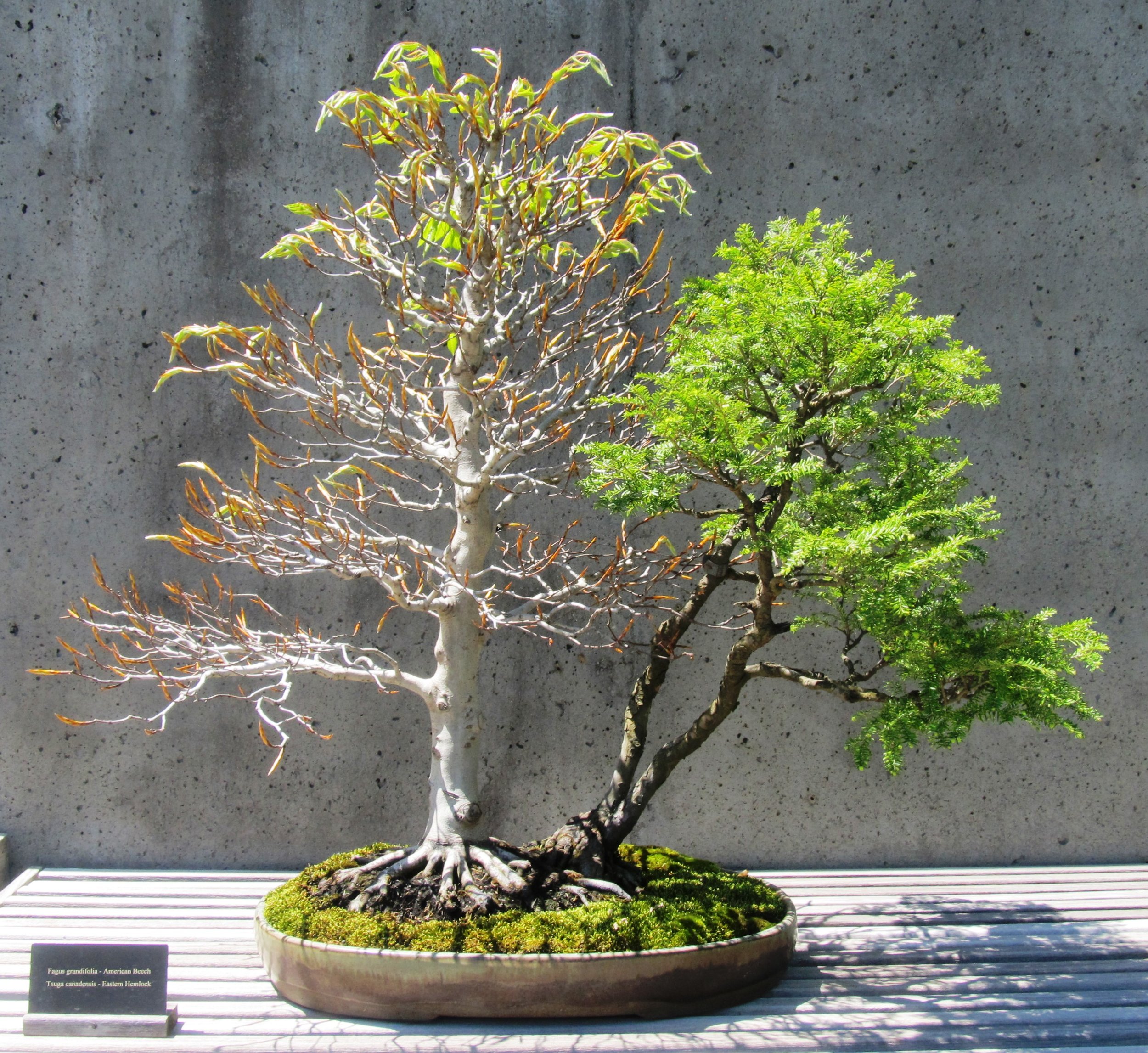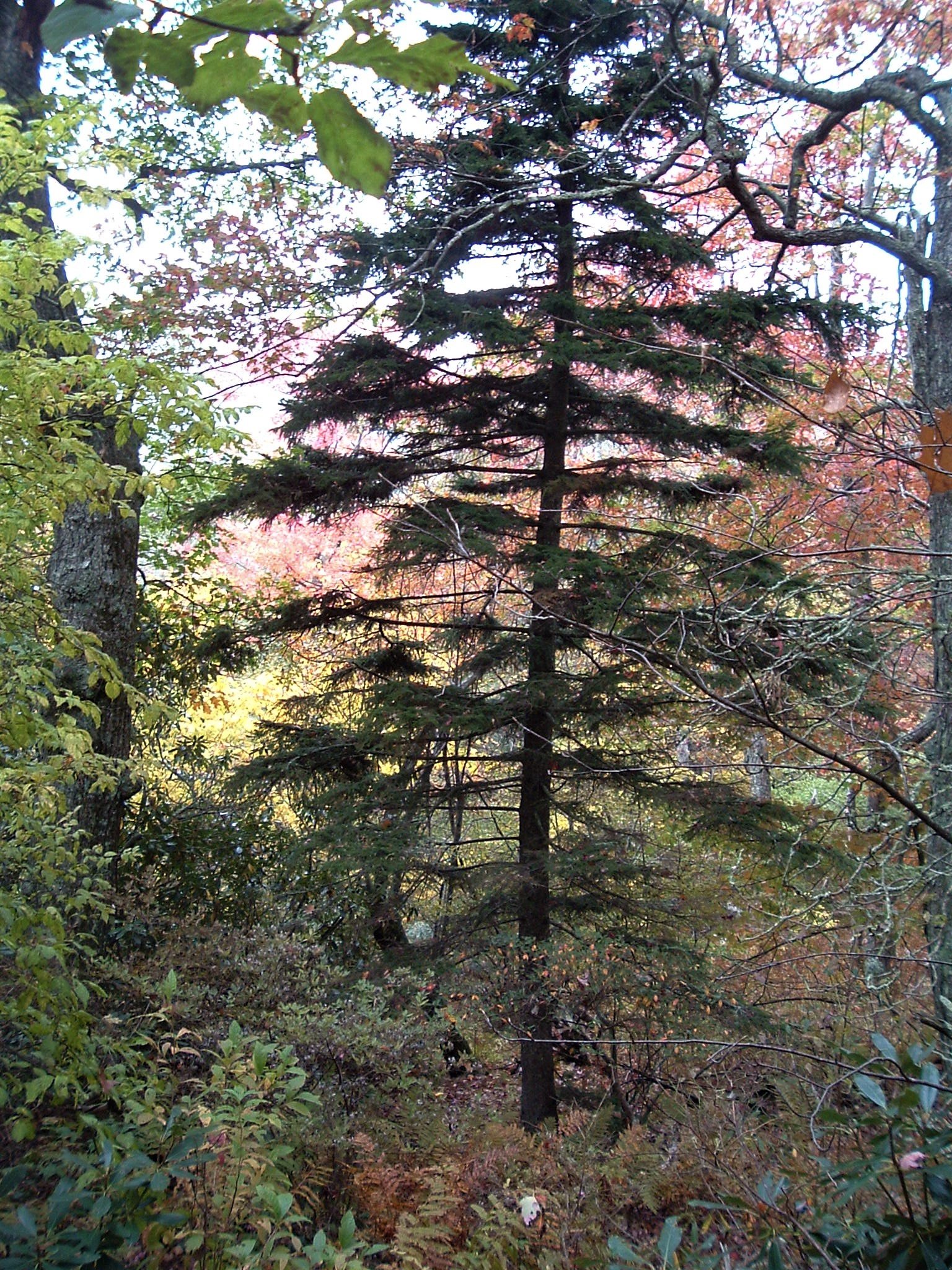Eastern Hemlock - Part 3
Even after removing the dead beech tree, I did not do much with the hemlock for a while. I spent the time taking care of other plants while keeping an eye on what remained of Mr. Yoshimura's tree and thinking about what to do next. In 2020 I finally decided the two remaining trunks of the hemlock might be able to stand on their own as a bonsai specimen. I had always seen those trees as being subsidiary to some larger element: first the original primary trunk of the hemlock and later the American beech that replaced it. Now it was time to evaluate them on their own.
The two trunks had grown in size over the twenty-five years since Mr. Yoshimura's donation, and of course that developmental time also increased their character. They had acquired a more aged look. The trunks featured sinuous movement but not much taper, and when I gave the foliage a good thinning out the tree reminded me of the austere brush and ink paintings on old Chinese scrolls. The two-trunk hemlock had a literati feeling.
Literati painting from the Song Dynasty (960-1127 CE). Attribution: Wikimedia Commons
Bonsai trees described as literati are typified by long trunks with prominent movement and little taper, with branching that is minimalist and open. The term literati refers to the Chinese monks who long ago practiced calligraphy and made brush paintings, often of old gnarly trees, as a meditative discipline. These paintings had influence on bonsai design in both China and Japan. Literati is more freestyle in attitude than most other bonsai, which is appealing to many people who mistakenly think that shaping a tree that way is easy because "anything goes." In practice, designing a literati bonsai is highly challenging. The minimalist nature of trees in this vein leaves less room for error and all elements of the tree must be more carefully arranged. The greater emphasis on line and movement requires trunks and branching that are visually interesting enough to be the central feature of the composition. The same precise control exercised by the old monks with their brushwork is needed by the grower who wants to make a literati bonsai.
Having decided to work with the two-trunk hemlock I went looking for a pot that might be right for it. Among the many bonsai pots we had in storage was a large crescent-shaped container made by Robert Wallace, purchased long ago and waiting all those years for the right plant to come along. After giving the hemlock a thorough pruning and then wiring and shaping what remained, I planted it in the crescent pot and a new phase of life began for both tree and container (click on any image in the gallery for a larger view):
When trying out a new bonsai idea you can never be certain if it actually works until you do it and then stand back and size up what you've done. I had mixed feelings about the new hemlock creation. I thought it had possibilities, but there were aspects of the design that didn't fall immediately into place. The main issue was the relationship between the two trunks because however I turned the tree it seemed those visual elements did not quite cooperate with each other. This was a revelation. When the two were in a supporting role with a larger, dominant third trunk (hemlock or beech), the focus was on the primary trunk and the lesser trunks did not receive such critical notice. Now they were front and center.
A big part of the problem was that the two were so similar in size. If you want to do a visual composition with two main elements, it is helpful if they are noticeably different from each other. If they are two of the same thing, then ideally one element should be dominant and one subordinate, because that makes it easier for the viewer to know what to look at first. A composition with two elements that are of roughly equal visual value creates ambiguity that is more static than intriguing. Beyond that concern, the two trunk lines did not harmonize so well together, visually bumping into each other even though they do not physically make contact except where they are joined at the base. These issues were enough to cause me to put the hemlock aside again, to let it grow and allow me the time to ponder the situation and develop a possible response. In 2022 I worked over the tree in detail once more and came up with this (click on any image in the gallery for a larger view):
Making one trunk shorter than the other was an easy enough solution to the concern that the two were of equal visual weight. Dealing with the visual conflict of overlapping trunks and branches was a stickier problem, but it turned out to be a somewhat transient dilemma. The images above show the hemlock stripped down to minimal foliage after the pruning that sets up the tree for a new year of growth. After that growth comes out, the view of trunk and branch lines is obscured. The look of the bonsai might be like a literati initially, but a short time later it takes on a much more fulsome appearance. Here it is, finally back out on display in the bonsai garden in 2022 after a four-year hiatus:
In early spring of 2023 the same strip-it-down, wire-it-up, tinker-with-the-details process was repeated (click on either image for larger view):
Here is the hemlock a short time later out on display in the bonsai garden:
Unlike most other needle-evergreen species, training wire gets tight and needs removal rather quickly on eastern hemlock bonsai. Mr. Yoshimura's tree came to us with wire scars and I have added my share to them over the years. Some of the pruning done on this specimen has regrettably been necessitated by a desire to get rid of branches badly scarred by wire left on too long. Having learned that lesson the hard way, we now closely monitor the hemlock as it begins pushing new growth and get the wire off as soon as it appears to be getting snug. That happens about four to six weeks after spring growth commences.
This final gallery of images shows our hemlock bonsai as it currently exists, having recently had all of this year's wire removed and having received considerable pruning of abundant new foliage (click on any image for larger view):
I am still trying to find a better way to present this specimen. It has been in the Arboretum's collection for almost three decades now and has been through numerous permutations in that time, but I still don't think it has arrived at its best look. That might be seen as a failure on my part. I don't view it that way, though, because I know that bonsai are living entities, always evolving, always changing whether you want them to or not. Starting out I would have been happy to have brought the three-trunk hemlock we received in donation back to a healthy and fully realized version of Mr. Yoshimura's original design, but that didn't happen. Later I would have gladly continued refining the bonsai that combined part of Mr. Yoshimura's hemlock with the beech grown from seed collected with the help of my little son, but that didn't happen either. Now I am working with the two remaining trunks of the hemlock and trying to bring them into better harmony with each other, always looking for a way to improve the composition and make the specimen better. That's the way the bonsai game is played.
(Click on any image below for larger view):
There is an aspect of this story from which I have thus far shied away, but it cannot be left unacknowledged. In the years since Mr. Yoshimura gave us his eastern hemlock bonsai a catastrophe has befallen that same species in the wild. Tsuga canadensis was an integral component of the forests in eastern North America — widespread, great in number, impressive in growth, vital to a healthy ecosystem, and beautiful to see. Eastern hemlocks are capable of living for more than five hundred years and attaining heights in excess of one hundred fifty feet. For most of the twentieth century some of the largest and oldest eastern hemlocks in the world were found in the southern Appalachian Mountains, including places like the Great Smoky Mountains National Park, Joyce Kilmer National Forest, the Big Ivy section of Pisgah National Forest and along the Blue Ridge Parkway in the Black Mountain range. All of these trees are now dead. They were killed by the hemlock wooly adelgid, a sap sucking bug native to East Asia that was accidentally introduced into the United States.
Old growth eastern hemlock, Joyce Kilmer National Forest, 1997
Eastern hemlock, near Mount Pisgah, 2007
The decimation of eastern hemlocks in our region has occurred in the last two decades, meaning that anyone who has been familiar with the forests of western North Carolina over that time span has been a witness to this tragic event. I saw the great old hemlock trees as they were and I watched them all get sick and die. There were old favorite places in the forest that I stayed away from for ten years or more, just so I would not have to see the sight. But lately I have been returning to some of these places because we cannot hide from the truth, and life, however badly altered, goes on. The forest is not a static and unchanging thing, any more than a bonsai is. Not everything that happens along the way in life is pleasant or good, but when it happens it becomes the new reality and we are obliged to accept it and move on to whatever comes next.
Old growth eastern hemlock, Great Smoky Mountains National Park, 1998
Same tree as above seen from opposite direction, 2012
View from Blue Ridge Parkway near Graveyard Fields, 2006 (hemlocks are lighter colored bluish-green; dark green trees are red spruce (Picea rubens)
Same view as above, 2011
Deceased old growth eastern hemlock over rock in foreground with another looming in the distance, Big Ivy section of Pisgah National Forest, 2023.
Deceased eastern hemlock, Cane Creek section of Pisgah National Forest, 2022.
Eastern hemlock as a species has not been wiped out entirely, so there is hope that someday in the future they may return to their former status as "The Redwoods of the East." I will not be around to see that day. Likewise, I will never again be able to talk to Mr. Yoshimura, or put my son on my shoulders to reach up and pick low hanging beech nuts. But the memory of all of it remains and is somehow contained in one two-trunk hemlock bonsai.



























